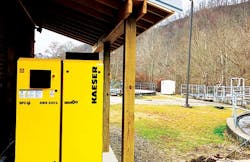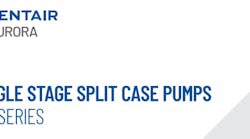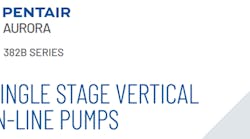Chapmanville Water Department in Logan County, West Virginia, provides the water distribution and wastewater treatment services in the town of Chapmanville, population 1,200. Their wastewater plant processes about 400,000 gallons per day. The town planned a major upgrade for 2019-2020, including the replacement of three 40 hp multi-stage centrifugal blowers commissioned twenty-five years earlier. At the beginning of 2018, one of these was no longer in service. Chapmanville planners hoped to limp along on the two remaining, but in the spring of 2018, they lost another blower. Down to one blower, they knew they could not simply wait for the planned upgrade. They had to do something.
Plans for the new plant included replacing all three 40 hp centrifugal blowers with two 60 hp blowers of the same type. They had estimated that they could supply both basins with air from one new blower, with 100% back up. But this did not solve their immediate problem. They got estimates to fix the blowers, but at $25,000 each this did not seem like a wise choice for a short-term solution.
Air Demand Analysis
The first required action was to measure current power consumption in order to quantify the actual savings (and provide a basis to estimate the potential incentive payment). Fortunately, Kaeser’s ADA was designed for this exact purpose. The ADA measurement plan included data logging the operation of the existing blower and measuring the power consumption.
With this performance data, Kaeser estimated that the town could save roughly $14,000 per year in power cost by installing rotary screw blowers controlled by variable speed drive. With the local utility’s incentive, they could receive an additional $14,000 once the power consumption was verified.
Solutions
Using the data collected during the ADA, Kaeser ran scenarios on two equipment solutions. In both cases, the 40 hp centrifugal units were replaced with 30 hp screw blowers offering more flow than the existing 40 hp units. One option offered fixed speed blowers and the other offered variable speed blowers.
Bonus: Improved Control of Dissolved Oxygen
The existing fixed speed system had been putting out full flow year-round with no Dissolved Oxygen (DO) controls. As it turned out, the DO levels were often much higher than necessary, indicating that much of the air production (and energy to make it) was wasted. It should be noted that this situation is common among treatment plants throughout the US, where operators must manually sample dissolved oxygen and manually throttle the flow to manage the DO in the basin.
Running the Numbers
The town chose the variable speed option with a total project cost of $112,000. This included the blower equipment, sensors and contracted plumbing, welding and electrical services.
After assessing the data, Appalachian Power concluded that Chapmanville would qualify for a one-time incentive payment of $18,298. This was 30% more savings than the initial estimation. So, with annual savings over $14,000 and a higher up-front incentive payment, the simple payback for the $112,000 project was just over five years.
Summary
By getting creative, Chapmanville was able to turn what looked like an impending crisis into a project which yielded both financial and operational gains. They leveraged newer blower technology, the opportunity to perform an accurate flow and power consumption assessment, and the availability of utility incentives to deliver value to the local tax payers through lower energy bills and better wastewater treatment.



